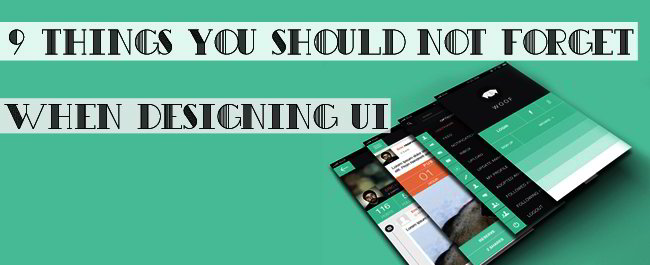9 Things You Should Not Forget When Designing User Interfaces
What is a good user interface? I asked myself this question today and here is what came to mind. Read on to find the 9 important ideas to keep in mind when designing user interfaces.

1. KISS and Ockham’s Razor.
KISS principle in really very simple (pun intended) – Keep It Short and Simple! It is widely believed (and I do agree with this) that a laconic and easy to understand design is way better than a complicated one.
Ockham’s Razor is a related principle that can be summarized as this – when faced with a problem that has more than one possible solution, choose the simplest solution, it most probably is the correct one. What does it have to do with interface design? It simply means that a user should be able to accomplish what needs to be done with the minimum actions. And again – the simpler interface is better than a complicated one.
2. Intuitive and straightforward.
That’s what your interface has to be. Your users should not have to memorize how the interface is supposed to work. Use visual cues such as icons, annotated illustrations, demos and walkthroughs and in-line hinting.
3. Don’t make them think.
Steve Krug in his book “Don’t Make Me Think” made this point clearer than I ever could. I suggest you read the book. In short the principle can be described as such – an effective interaction can not require a significant amount of thought to figure out. The layout and elements are to be rationally sound and clear.
4. Only necessary elements.
Omit all the unnecessary elements. If the interface can be used without it delete it!

5. Content is King.
Yeah, yeah, you have heard it plenty of times. But it’s still true, isn’t it? Copywriting is interface design.
6. Tried and true…
I’m not saying you should never-ever use new trends in your design approach. Do try new things. Just don’t innovate for the sake of being different. Use the elements that have proven to be effective.
7. Miller’s law.
According to Miller an average person can hold 7 objects in his working memory. That’s why it’s been agreed that a function block should contain about 5-7 elements. You don’t want to overwhelm your user after all.
8. Consistency.
A website design needs to be predictable. Inconsistency in design makes it less usable and thus frustrates the visitor.
9. People scan, they do not read.
Don’t make your users read a page full of text. They don’t like reading, they have no time for it. Make sure they can scan the page and find the important parts. Make the crucial things visible and do not forget that your call to action has to be very clear.
Well, that’s pretty much it. And I think these above principles can be applied to website design as a whole. What do you think?
